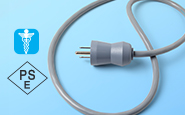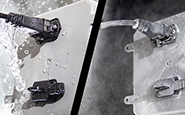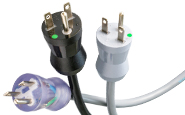Featured Product
A module simplifies the power entry element by combining multiple functions into a single unit.
Module Functions and Components
When selecting a module, the desired functions need to be determined. A module may have from two to five functions. These include: power inlet or outlet, switch, circuit protection, filter, and/or voltage selector.
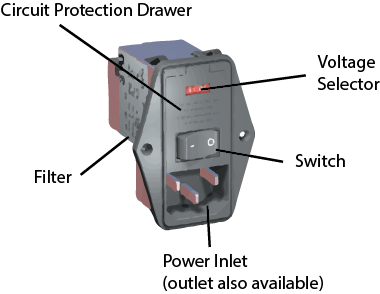 |
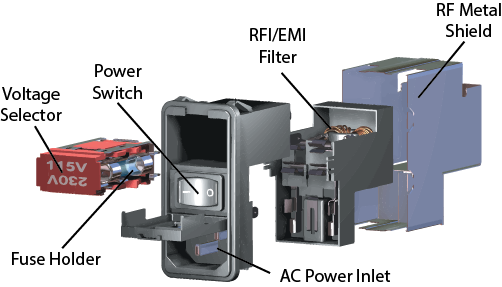 |
| An example of a multi-function power entry module. |
Inlet
The power inlet is responsible for bringing electricity into the unit via a detachable cord set. The most common inlet is the IEC 60320 C14, although other IEC 60320 style inlets, such as the C6, C8, and C20, are occasionally offered by some manufacturers. Modules using the C14 inlet are typically specified for applications 10A and below.
Outlet
An outlet is an IEC 60320 connection device that provides access to electricity from a power source. Outlets range from 10-20 amps.
Switch
The switch is used to turn the power on (“│”) and off (“O”) from the module to the rest of the unit. The “│” marking on the module needs to be vertical when mounted. Rocker-style switches are the choice of module manufacturers. Some modules use a double-pole, single-throw switch and others use single-pole, single-throw switch. While unlighted switches are the most common, they can be either lighted or unlighted.
Circuit Protection
Circuit protection takes the form of a circuit breaker or a fuse. Both provide current protection to the equipment, reducing the possibility that a short circuit can damage the equipment or harm the user.
When a product is being designed for multiple markets, a fuse has an advantage over a circuit breaker in that it costs less and is easier to modify. Also fuses can be sized to match the application, such as a single module used in multiple applications. Circuit breakers installed in modules, however, are limited to the size/rating of the breaker. Fuses also have different clearing characteristics (fast-acting, slow blow, etc.) that allow for an additional fine-tuning of applications.
Fuse holders and carriers are commonly built into modules as to provide circuit protection against abnormal surges and overloads. When determining the amp rating of the fuse, it should not exceed the overall rating of the module.
Most modules with fusing capability must be specified as either a single-fuse or a double-fuse depending on the application. Some can be configured either way.
Modules do not come with fuses—they must be ordered separately for liability reasons. It is the equipment manufacturer’s responsibility to determine the best fuse for the application and order it for optimal performance.
Fuses come in two different sizes. In North America, the standard size is ¼ x 1¼–inch while the common size in international markets is 5 x 20mm. The smaller international fuse is starting to become more prevalent in North America. Some modules can accept both sizes of fuses, while other modules are designed to only accept one size. It’s important to check fuse size specifications of any module being considered in order to choose the best one for a specific application.
Filter
A filter is an important part in equipment design, especially in high-frequency and medical equipment applications. It can remove specified Radio Frequency and Electromagnetic Interference (RFI/EMI) that affects equipment operation. A filter helps to provide clean electricity to the equipment.
The circuit components of filters are inductors and capacitors. The difference between a standard filter and a medical-grade filter is that capacitors between the circuit conductors have been removed in the medical versions in order to decrease leakage current. This is important for equipment where leakage current values are tightly controlled by safety standards ensuring patient safety.
Interpower filtered power entry modules are available with or without a metal shield, typically specified in high-frequency applications. An RFI/EMI filter is designed to remove electromagnetic and radio frequency interference (noise) from the equipment. This prevents malfunctions due to interference and also prevents the equipment from radiating noise, which might interfere with other equipment.
Whenever specifying a module with a filter, it is necessary for a company to obtain samples to test with one’s application to ensure they will perform as desired. This is because filter performance specifications are based on an industry standard 50 ohm test circuit and certain aspects of an application’s design may alter the way a filter performs when the circuits are connected.
Voltage Selector
Voltage selection allows equipment to be designed and manufactured to operate on approximately 115 or 230VAC. A voltage selector changes voltage by changing connections on the transformer. By changing the selection, this allows the user to define the correct input voltage. Voltage selection changes are made by removing the fuse holder and rotating it. It is important to note that the voltage selector is a specialized switch which works in conjunction with a transformer that is designed into the customer’s equipment. The transformer is not part of the actual module, but it creates alternate circuit paths for the voltage selection process. If the customer has a switched mode power supply (which is any power supply between 90-264V), then a voltage selector is not needed.
Hospital-Grade Power Entry Modules
Hospital-grade equipment must meet special requirements. These requirements place special significance on fusing and filtering when selecting components used in medical equipment. Patient-connected medical equipment can be subjected to low-leakage current requirements. The use of a low-leakage filter in the 5µA range at 250VAC is desirable. In addition, fusing of both line and neutral may be required (i.e. double fusing). For more information, see Hospital-Grade Power Entry Modules and “More Information on Hospital-Grade Products” on the Interpower website.
Additional Resources
Interpower offers free technical support. For more information to determine which kind of module is best for a specific product design, contact Customer Service. See the complete line of modules and fuses and fuse holders available at Interpower. See also "More Information on Power Entry Modules."


